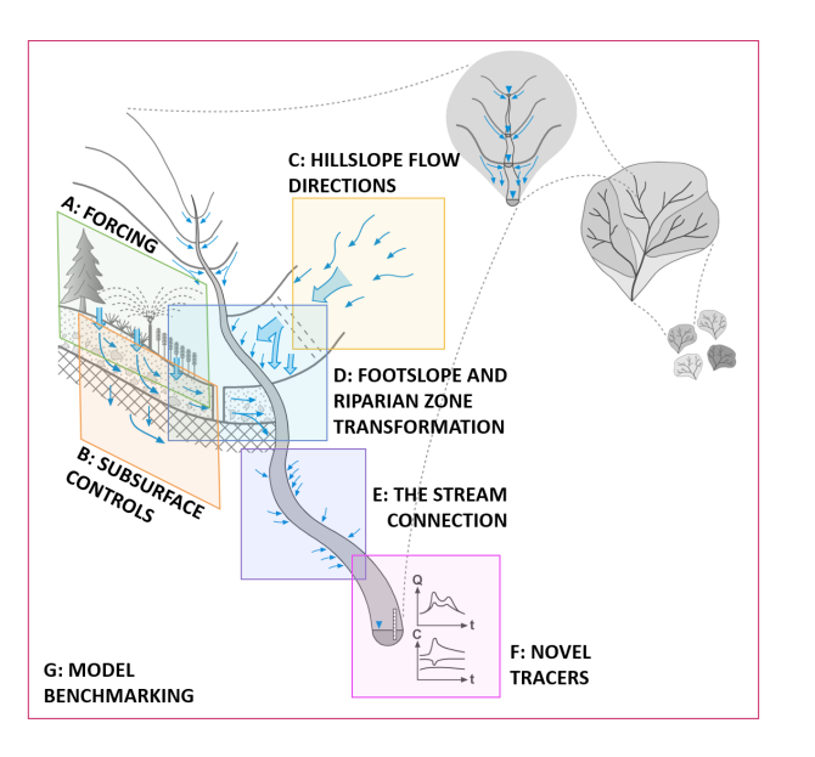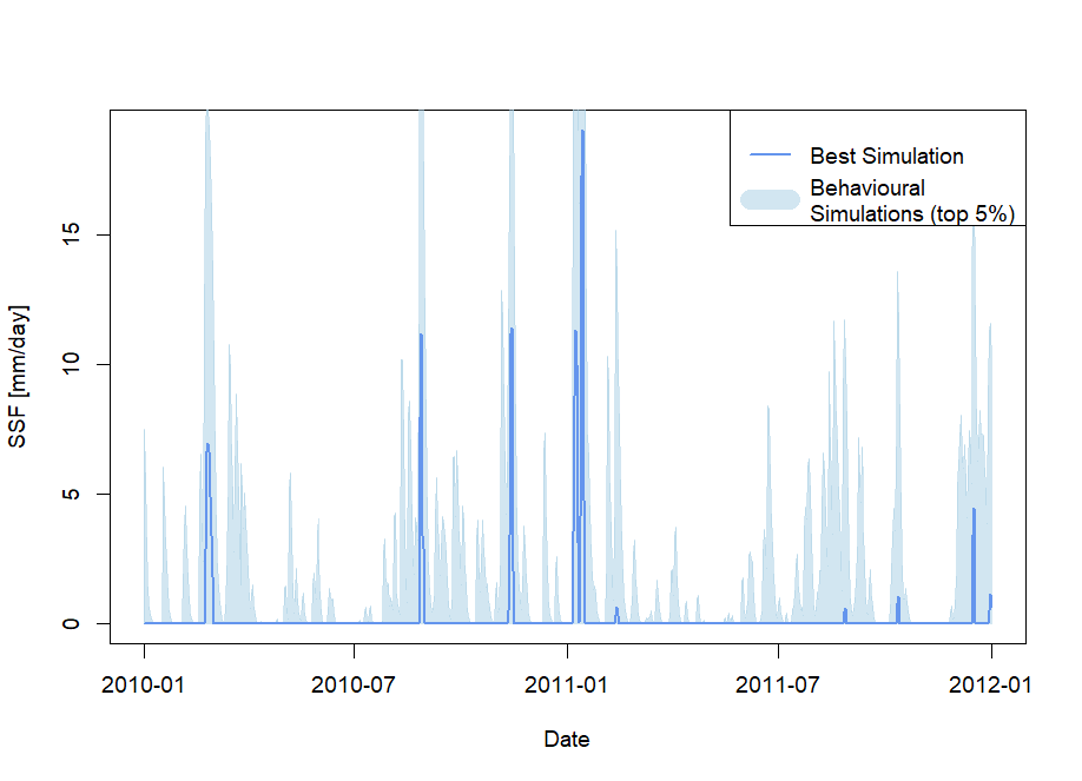G SSF MODEL BENCHMARKING- Towards a robust parameterization of SSF in hydrological models at the catchment scale [funded by DFG]
Project staff:
Andreas Hartmann
Tamara Lisa Leins
Dr. Christian Reinhardt-Imjela
Nikolai Späth
Benjamin Grahler
Abstract:

Project G benchmarks existing SSF approaches in catchment scale hydrological models and aims at an improved and robust SSF parameter extimation by the integration of proxy data in a multi-objective calibration.
With a general lack of understanding of the occurrence of and controls on SSF, there is also a resulting lack of SSF observations. Consequently, only very few modelling studies focus on the realistic simulation of SSF and a quantification of goodness-of-fit for streamflow contribution of rapid subsurface flow processes beyond the hillslope scale. The information content of time series of total discharge at the catchment outflow, on which calibration is usually based, is limited and model internal distinction of lateral flow paths like surface runoff, SSF, groundwater, etc. remains uncertain. There is a high chance of equifinality of simulated processes and parameters. While previous studies did not see SSF as a process verifiable by SSF observations they also focused on one site and one hydrological model. We therefore task a systematic benchmarking and improvement of SSF routines in hydrological models at catchments with different climates and properties.
Reseach questions :
1.) What are the potential benefits and limitations of Synthetic Biology applications for sustainable development (including environmental, economic and social aspects)? 2.) How can synthetic biology contribute to the sustainable transformation of industrial sectors (e.g., chemicals, agriculture, textiles, etc.) 3.) What are the potential risks and unintended consequences of synthetic biology innovations? 4.) How can governance frameworks be designed to ensure responsible research and innovation in synthetic biology? 5.) How can public engagement and dialogue be fostered around synthetic biology to build trust and ensure inclusive decision-making? 6.) What interdisciplinary approaches are needed to address the complex challenges and opportunities associated with synthetic biology?
Methods

At first we will benchmark how well temporal and spatial patterns of SSF are reproduced by a wide range of rainfall-runoff modelling concepts with different approaches for the simulation and calibration of SSF. The selection includes the lumped, conceptual models HBV and TOPMODEL, the distributed, conceptual model NASIM and the distributed physically-based model system WaSiM-ETH. Applied to four catchments with different climatic and hydrological characteristics from low to high mountain areas (Sauerland, Ore Mountains, Black Forest, Alps), the model setup and calibration in this step is only based on discharge observations and basic catchment properties such as soil maps. For benchmarking of model performance, we will evaluate the models using standard statistical metrics (coefficient of determination, Nash-Sutcliffe efficiency and Kling-Gupta efficiency). For benchmarking of model uncertainty, a sensitivity analysis within a consistent framework across all model types based on the workflow proposed by Pianosi et al. (2016) will be carried out. In the next step SSF proxies obtained by the other projects will be used to benchmark how well the catchment-scale models capture the spatiotemporal dynamics of SSF. The newly obtained SSF data will also be transformed into SSF metrics and used as a reference for multi-objective model calibration with regard to simulated SSF and discharge. The most useful combination of discharge and SSF proxies will be determined for each model and field site and another sensitivity analysis run will benchmark the uncertainty of SSF simulations when SSF proxy data is available. Eventually the results will provide an improved understanding of what kind of data sets from the field monitoring projects are most suitable for model improvement. They will also show, how the monitoring networks have to be refined and complemented in terms of spatial distribution of measuring equipment. In the last step we will apply the improved models that showed realistic and robust SSF simulations for a much longer time period of available model input. This will allow to unravel the occurrence and importance of SSF hidden in catchment discharge and to explore sensitivity of SSF dynamics to climate variability. With long-term quantitative information on SSF occurrence and volumes available for all four catchments, we will explore relationships between SSF dynamics and each catchment’s storage characteristics and subsurface structure.

Achievements
- Simulated contributions of SSF to total discharge show large variations between different model structures as well as between different model parameterisations. - Especially in NASIM and WaSiM, simulated discharge components show distinct differences between the catchments. - In general, model-internal flow components show a large model structure uncertainty and parameter uncertainty. - SSF parameters are mostly insensitive and therefore difficult to identify. However, there are some exceptions. - Simulated SSF volume and occurrence are highly uncertain in most models. Simulated SSF timing seems to be more consistent along model structures and parameterisations. - In an attempt to extract more information from discharge data by calibrating on flow duration curve percentiles, the identifiability of SSF parameters was only slightly improved.
Publications and poster presentations:
- Späth, N.; Leins, T.L.; Reinhardt-Imjela, C. & Hartmann, A. (2025.03.20). Benchmarking und multikriterielle Kalibrierung von flächenkonzentrierten und flächendetaillierten Niederschlag-Abfluss-Modellen zur Abbildung von schnellen unterirdischen Abflusskomponenten. Presented at Tag der Hydrologie, Augsburg.
2024 - Späth, N.; Reinhardt-Imjela, C.; Leins, T.L. & Hartmann, A. (2024.11.28). Subsurface Stormflow Model Benchmarking: Towards a robust parameterization of SSF in hydrological models at the catchment scale. Presented at Jahrestreffen Arbeitskreis Hydrologie, Würzburg.
2023 - Pianosi, F.; Leins, T.L. & Hartmann, A. (2023.04.28). Towards a robust parameterization of subsurface stormflow in hydrological models at the catchment scale. Presented at EGU General Assembly 2023, Vienna, Austria.
- Kuleshov, A.; Hartmann, A.; Blume, T. & Hopp, L. (2023.04.28). The riparian zone as a gatekeeper for subsurface stormflow. Presented at EGU General Assembly 2023, Vienna, Austria.
- Hartmann, A.; Payeur-Poirier, J. & Hopp, L. (2023): Incorporating experimentally derived streamflow contributions into model parameterization to improve discharge prediction. Hydrology and Earth System Sciences 27(6), 1325–1341
2019 - Chifflard, P.; Blume, T.; Maerker, K.; Hopp, L.; van Meerveld, I.; Graef, T.; Gronz, O.; Hartmann, A.; Kohl, B.; Martini, E.; Reinhardt-Imjela, C.; Reiss, M.; Rinderer, M. & Achleitner, S. (2019): How can we model subsurface stormflow at the catchment scale if we cannot measure it?. Hydrological Processes 33(9), 1378-1385
2018 - Reinhardt-Imjela, C.; Maerker, K.; Schulte, A. & Kleber, A. (2018): Implications of hydraulic anisotropy in periglacial cover beds for flood simulation in low mountain ranges (Ore Mountains, Germany). DIE ERDE – Journal of the Geographical Society of Berlin 149(2-3), 86-101
